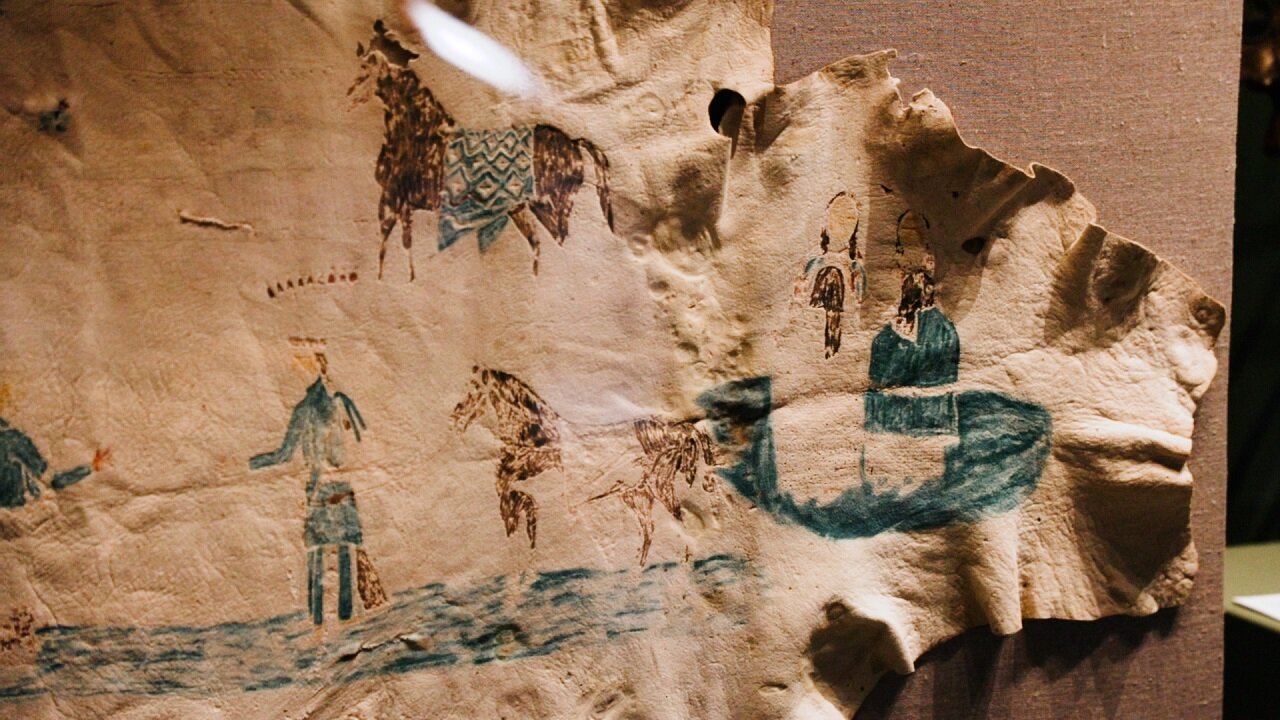Colorado’s longest residents tell their own history

IGNACIO, Colo. — At the convergence of two major roads in Ignacio, home of the Southern Ute Tribe, sits an awe-inspiring building. The tribe built this structure, which is surrounded by gardens and nature, to reach toward the sky. Every part of the building was created with input from the community.
“The space is for us to be able to tell our story. Different tribal members have either loaned or donated some of their items here to be on display,” said Crystal Rizzo, the cultural preservation director at the Southern Ute Cultural Center and Museum.
Inside the museum, visitors are greeted with a three-story tall pole that extends from the center of the lobby. At the top of the pole is a circular skylight divided into four sections, representing the seasons and the circle of life. The entrance of the building faces east to welcome the rising sun.

The sky light at the center of the museum has a circle in the middle divided into four different colored panes that represent the seasons.
“I know when we were even making the building, there was a lot of community input and gathering so that we would be able to say what things we wanted,” explained Rizzo. “We wanted it to be shaped a certain way. We want the doors facing a certain way, like the building is round … there's a wing for cultural classes. We have a sewing room for elders; we have a large classroom where we host different events.”
The museum opened in 2011 with a permanent exhibit that tells the complete history of the Utes. Visitors can explore cave drawings, a tipi, articles of clothing made with hundreds of beads and more. They can also learn about the notorious boarding schools where Native children were taken from their families to assimilate into American culture. The exhibit concludes with a more recent history of life on the Southern Ute reservation.
[Watch now: Colorado Voices: An Indian Boarding School]
The Utes inhabited vast areas of Colorado, Utah, Wyoming, Nevada, New Mexico and Arizona for thousands of years. Before the introduction of horses to North America, the Utes lived off the land and traversed large areas dependent on the season. Later, horses gave the Utes a greater ability to travel down from the mountains and hunt bigger game like buffalo.

This buffalo-hide artwork hangs in the permanent exhibit in the Southern Ute Cultural Center and Museum.
White settlers took land from the Utes, often through violence. In 1868, the Utes were forced onto a 50-million-acre reservation that covered the western half of Colorado. In 1873, once gold and silver were discovered in the San Juan Mountains, the Ute lands shrank even more. The Southern Ute Reservation was created just before the turn of the 20th century. Located in southwest Colorado, the reservation is 15 miles wide and 110 miles long. The land on the reservation was divided; some of it was allotted to tribal members and the surplus land was homesteaded or sold to non-Indians.

This map shows the division of land of the Southern Ute Indian Reservation which is only 15 miles wide and 110 miles long.
Much of the Ute culture is represented in other parts of the museum as well. In the lobby, sits a bear totem pole showing respect and relationship with bears and other animals. The Bear Dance, which takes place every spring, is a ceremony and gathering that symbolizes the new year with new life as the bear comes out from hibernation.
The museum also hosts a library and learning classrooms where the Ute language is continually taught, something Rizzo believes is extremely important.
“I think that language is fundamental to your identity. Being able to communicate with the Creator in your own language I think is so important and then, of course, language impacts every bit of everything else,” Rizzo said.
One of the Southern Ute’s 1,500 tribal members, Rizzo, was adopted and raised off the reservation and came back two years ago for the language program.
“Being able to contribute to my people, my community, in a way that I think helps us to be able to … practice our sovereignty and strengthen our sovereignty — that's really why I'm here.”

Crystal Rizzo is the cultural preservation director at the museum and encourages everyone to come to the museum with curiosity and respect.
To learn more about the Southern Ute Cultural Center and Museum, head to their website.
You can also read more about the history of Colorado’s longest residents here.
Part of the Southern Ute history and two tribal members will be featured in an upcoming episode about buffalo in Colorado in the next season of Colorado Experience.
Amanda Horvath is the managing producer at Rocky Mountain PBS. You can reach her at amandahorvath@rmpbs.org.
Alexis Kikoen is the executive producer at Rocky Mountain PBS. You can reach her at alexiskikoen@rmpbs.org.
